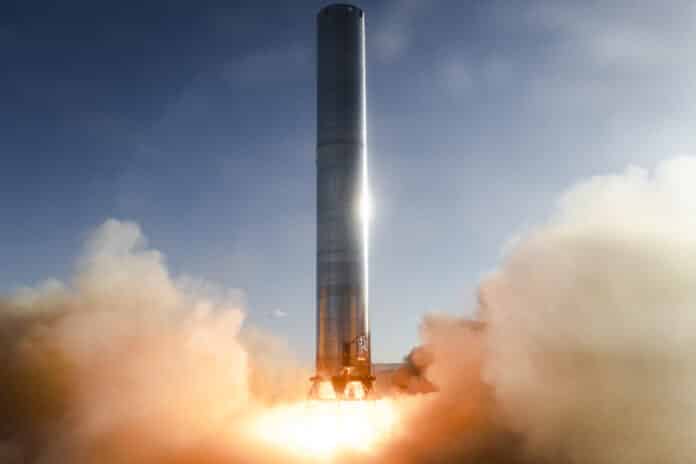The first rocket engines to be lit at SpaceX’s Boca Chica site since the May 5 flight of the Starship SN15 prototype roared to life a few minutes after 7 p.m. on July 19.
These particular three liquid oxygen/liquid methane-fueled Raptor engines were attached to the first Super Heavy booster stage SpaceX has tested so far, known as Booster No. 3, BN3 or simply B3, which was rolled out from the Boca Chica production complex down S.H. 4 to the launch pad on July 1.
“Full test duration test firing of 3 Raptors on Super Heavy Booster!” SpaceX founder and CEO Elon Musk tweeted Monday.
Standing at 250 feet tall, the B3 is even more visible on the launch pad from miles away than the 165-foot-tall, full-size Starship prototypes, testing of which over the past year has ended in a series of failures and nearly complete successes — until the hitch-free launch, descent and landing of SN15 on an overcast day in May.
The Super Heavy is being designed to push Starship into orbit. Musk wrote on Twitter that, depending on the progress of Super Heavy B4, construction of which started this month, B3 could be outfitted and tested with nine engines.
The fully orbital version of Super Heavy will be fitted with 33 Raptor engines, while Starship itself would feature six to nine Raptors, according to Musk. SpaceX President and Chief Operating Officer Gynne Shotwell said last month that the company was shooting for the first orbital launch of the Starship-Super Heavy this month. If that projection turns out to be overly optimistic, it wouldn’t be the first time for the company.
At Boca Chica SpaceX is completing an “integration tower” taller than the combined Starship-Super Heavy and which the company says will be used to attach the two stages, resulting in a behemoth nearly 400-foot-tall, almost 100 feet taller than the Statue of Liberty including its pedestal, but not for actual launches.
However, the Federal Aviation Administration last week warned that the tower, which the FAA is including in an ongoing environmental review of SpaceX’s next-phase testing program at Boca Chica, might not be approved, in which case SpaceX would have to take it down.
“The company is building the tower at its own risk,” an FAA spokesman told CNBC on July 14.
What if any impact this will have for orbital launches of Starship-Super Heavy in the near future isn’t clear, though SpaceX is also in the process of converting two former offshore oil rigs into offshore launch platforms for launches next year, according to Musk.
The floating launch pads, one being refitted at the Port of Brownsville and the other at Pascagoula, Miss., have been named Deimos and Phobos after the two moons of Mars. Musk’s plan is for Starship to carry humans to the moon and Mars in the not-too-distant future.
“SpaceX is building floating, superheavy-class spaceports for Mars, moon & hypersonic travel around Earth,” Musk tweeted in July 2020, observing that launches of the Starship-Super Heavy “are not subtle” and that protecting heavily populated areas from extreme noise levels means they would need to take place miles offshore.




